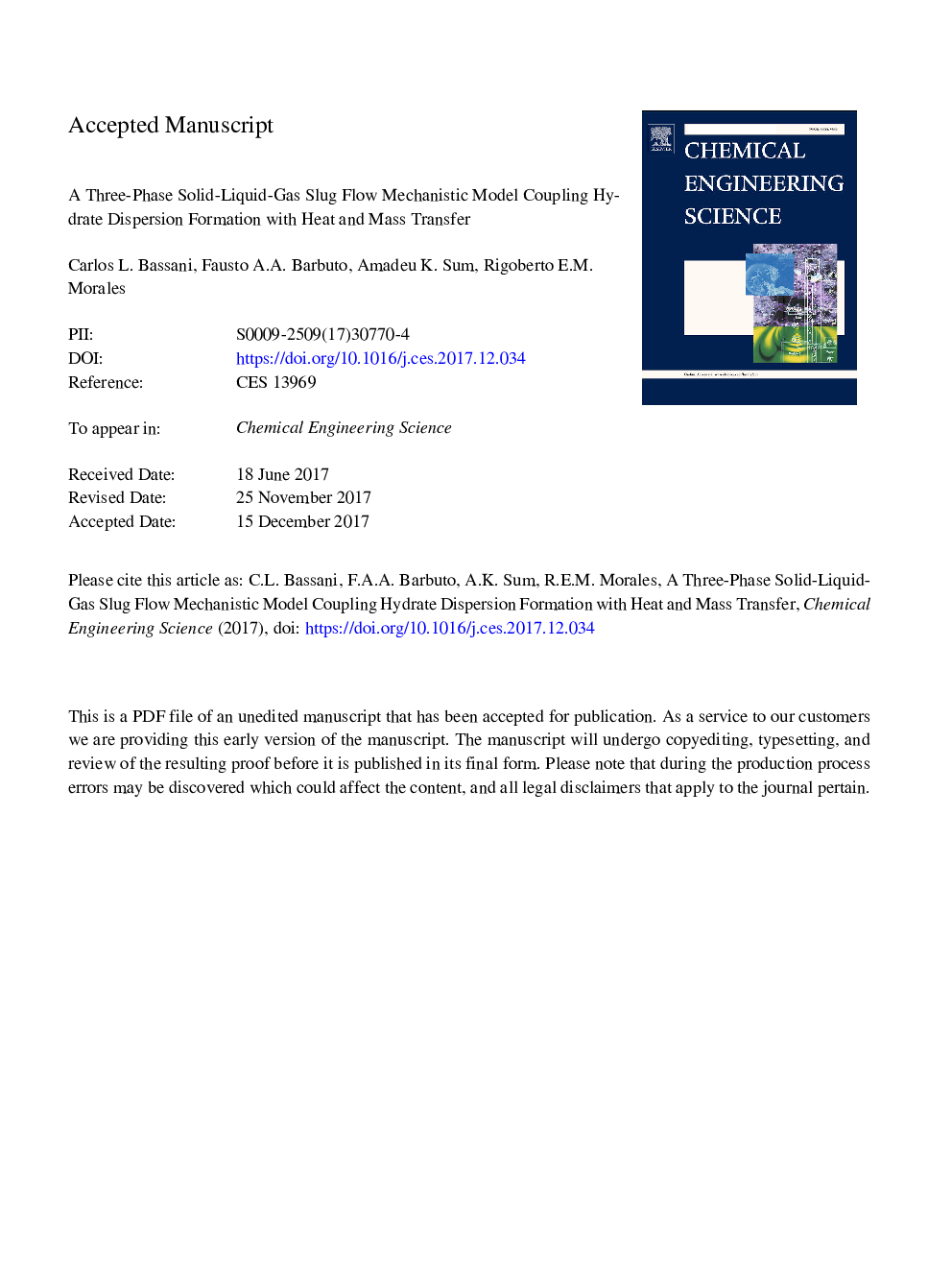| کد مقاله | کد نشریه | سال انتشار | مقاله انگلیسی | نسخه تمام متن |
|---|---|---|---|---|
| 6588717 | 1423241 | 2018 | 44 صفحه PDF | دانلود رایگان |
عنوان انگلیسی مقاله ISI
A three-phase solid-liquid-gas slug flow mechanistic model coupling hydrate dispersion formation with heat and mass transfer
ترجمه فارسی عنوان
یک مدل مکانیکال جریان سه فاز مایع گاز مایع با همدستی از تشکیل پراکندگی هیدرات با انتقال حرارت و جرم
دانلود مقاله + سفارش ترجمه
دانلود مقاله ISI انگلیسی
رایگان برای ایرانیان
کلمات کلیدی
اطمینان جریان، هیدراتها مدل سازی جریان چند مرحلهای، جریان شیرابه جامد مایع گاز سه فاز، انتقال حرارت و جرم،
ترجمه چکیده
انسداد لوله به علت تشکیل هیدرات گاز، نگرانی اصلی در صنعت نفت و گاز به علت تلفات ناشی از تخریب تولید یا وقفه های تولید و همچنین هزینه های بالا در ارتباط با از بین بردن چنین انسداد ها است. با فرض سرعت تشکیل هیدرات در رابط گاز و آب بر اساس خنک کننده سیستم، کار حاضر مدل انتقال از دو فاز مایع گاز به جریان سه فاز جریان جامد مایع - زمانی که هیدرات شکل می گیرد. جریان چند مرحلهای در داخل منطقه الگوی جریان شارژ قرار دارد، زیرا این رژیم جریان غالب در سناریوهای تولید دریایی است. مدل توده، جرم و انعطاف پذیری انرژی را برای سلول واحد جریان انبساط جفت می کند. فاز هیدرات به صورت همگن در آب پراکنده می شود. نرخ مصرف گاز و آب به علت تشکیل هیدرات به عنوان اصطلاحات منبع در معادلات توازن توده ای مدل سازی می شود. خصوصیات اکسوترمیسیون تشکیل هیدرات در معادله ذخیره انرژی مورد توجه قرار گرفته است. این مدل عبارات تحلیلی برای توزیع دما و فشار در طول خط لوله ارائه می دهد. با این حال، هندسه سلول واحد با یکپارچگی عددی حل می شود و بسته شدن مدل تنها زمانی حاصل می شود که همبستگی تجربی برای فرکانس شبیه ساز، سرعت انتقال متحرک سلولی و هوای شبیه سازی استفاده شود. نتایج شبیه سازی عددی برای پارامترهای ورودی مشابه برای موارد با تشکیل و یا بدون تشکیل هیدرات ارائه شده است. بحث بر روی تأثیر تشکیل هیدرات در جریان هیدرودینامیک جریان جریان و انتقال حرارت است. مکانیسم اصلی تأثیر دما و توزیع فشار مخلوط، ضریب انتقال حرارت مخلوط، سرعت های سطحی فازها، بارگذاری مایع، فرکانس جریان لجن و هندسه سلول واحد ارائه شده است.
موضوعات مرتبط
مهندسی و علوم پایه
مهندسی شیمی
مهندسی شیمی (عمومی)
چکیده انگلیسی
Pipe blockage due to gas hydrate formation is a main concern in the oil and gas industry due to the revenue losses caused by either production impairments or interruptions, and to the high costs associated to the elimination of such blockages. Assuming a hydrate formation rate in the gas-water interface based on the system subcooling, the present work models the transition from two-phase liquid-gas to three-phase solid-liquid-gas flows when hydrates form. The multiphase flow is assumed to be within the slug flow pattern region, as this is the prevailing flow regime in offshore production scenarios. The model couples mass, momentum and energy balances for the slug flow unit cell. The hydrate phase is assumed as homogeneously dispersed in the water. The gas and water consumption rates due to hydrate formation are modeled as source terms in the mass balance equations. The exothermic characteristic of the hydrate formation is taken into account in the energy conservation equation. The model provides analytic expressions for temperature and pressure distributions along the pipeline. However, the unit cell geometry is solved by numerical integration and the model closure is achieved only when empirical correlations for the slug frequency, the unit cell translational velocity and the slug aeration are used. The results from the numerical simulations are presented for the same input parameters for cases with and without hydrate formation. The discussion focuses on the influence of hydrate formation in the slug flow hydrodynamics and heat transfer. The main mechanisms affecting the mixture temperature and pressure distributions, the mixture heat transfer coefficient, the superficial velocities of the phases, the liquid loading, the slug flow frequency and the unit cell geometry are presented.
ناشر
Database: Elsevier - ScienceDirect (ساینس دایرکت)
Journal: Chemical Engineering Science - Volume 178, 16 March 2018, Pages 222-237
Journal: Chemical Engineering Science - Volume 178, 16 March 2018, Pages 222-237
نویسندگان
Carlos L. Bassani, Fausto A.A. Barbuto, Amadeu K. Sum, Rigoberto E.M. Morales,
